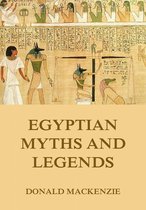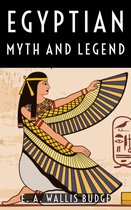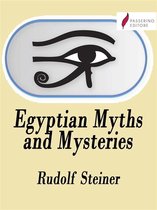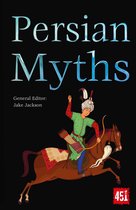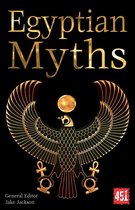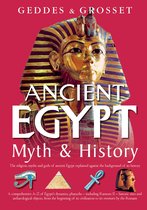Egyptian Myth and Legend Ebook Tooltip Ebooks kunnen worden gelezen op uw computer en op daarvoor geschikte e-readers.
Afbeeldingen
Sla de afbeeldingen overArtikel vergelijken
- Engels
- E-book
- 9781613102114
- 29 juli 2009
- Adobe ePub
Samenvatting
In this volume the myths and legends of ancient Egypt are embraced in a historical narrative which begins with the rise of the great Nilotic civilization and ends with the Græco-Roman Age. The principal deities are dealt with chiefly at the various periods in which they came into prominence, while the legends are so arranged as to throw light on the beliefs and manners and customs of the ancient people. Metrical renderings are given of such of the representative folk songs and poems as can be appreciated at the present day. Egyptian mythology is of highly complex character, and cannot be considered apart from its racial and historical aspects. The Egyptians were, as a Hebrew prophet has declared, a "mingled people", and this view has been confirmed by recent ethnological research: "the process; of racial fusion begun in the Delta at the dawn of history", says Professor Elliot Smith, "spread through the whole land of Egypt". In localities the early Nilotic inhabitants accepted the religious beliefs of settlers, and fused these with their own. They also clung tenaciously to the crude and primitive tribal beliefs of their remote ancestors, and never abandoned an archaic conception even when they acquired new and more enlightened ideas; they accepted myths literally, and regarded with great sanctity ancient ceremonies and usages. They even showed a tendency to multiply rather than to reduce the number of their gods and goddesses, by symbolizing their attributes. As a result, we find it necessary to deal with a bewildering number of deities and a confused mass of beliefs, many of which are obscure and contradictory. But the average Egyptian was never dismayed by inconsistencies in religious matters: he seemed rather to be fascinated by them. There was, strictly speaking, no orthodox creed in Egypt; each provincial centre had its own distinctive theological system, and the religion of an individual appears to have depended mainly on his habits of life. "The Egyptian", as Professor Wiedemann has said, "never attempted to systematize his conceptions of the different divinities into a homogeneous religion. It is open to us to speak of the religious ideas of the Egyptians, but not of an Egyptian religion." In our introduction we deal with the divergent character of some of the ancient myths so as to simplify the study of a difficult but extremely fascinating subject. It is shown that one section of the people recognized a Creator like Ptah, who begot himself and "shaped his limbs" ere he fashioned the Universe, while anOther section perpetuated the idea of a Creatrix who gave birth to all things. At the dawn of history these rival conceptions existed side by side, and they were perpetuated until the end. It is evident, too, that the theologies which were based on these fundamental ideas had undergone, ere the fusion of peoples occurred, a sufficiently prolonged process of separate development to give them a racial, or, at any rate, a geographical significance. As much is suggested by the divergent ideas which obtained regarding the world. One section, for instance, had conceived of land surrounded by sky-supporting mountains, peopled by gods and giants, round which the sun ass galloped to escape the night serpent; anOther section believed that the world was embraced by the "Great Circle"--Ocean--and that the Nile flowed from sea to sea; a third conception was of a heavenly and an underground Nile. There were also two Paradises--the Osirian and the Ra (sun god's). Osiris judged men according to their deeds. He was an agricultural deity, and the early system of Egyptian ethics seems to have had its origin in the experiences enshrined in the text: "Whatsoever a man soweth that shall he also reap". Admission to the Paradise of the sun cult was secured, on the Other hand, by the repetition of magical formulæ. Different beliefs obtained also regarding the mummy. In of the Dead it would appear that the preservation of the body was necessary for the continued existence of the soul. Herodotus, however, was informed that after a period of 3000 years the soul returned to animate the dead frame, and this belief in transmigration of souls is illustrated in the Anpu-Bata story, and is connected with a somewhat similar conception that the soul of a father passed to a son, who thus became "the image of his sire", as Horus was of Osiris, and "husband of his mOther
Productspecificaties
Inhoud
- Taal
- en
- Bindwijze
- E-book
- Oorspronkelijke releasedatum
- 29 juli 2009
- Ebook Formaat
- Adobe ePub
- Illustraties
- Nee
Betrokkenen
- Hoofdauteur
- Donald Mackenzie
- Hoofduitgeverij
- Library Of Alexandria
Lees mogelijkheden
- Lees dit ebook op
- Android (smartphone en tablet) | Kobo e-reader | Desktop (Mac en Windows) | iOS (smartphone en tablet) | Windows (smartphone en tablet)
Overige kenmerken
- Studieboek
- Ja
EAN
- EAN
- 9781613102114
Je vindt dit artikel in
- Categorieën
- Taal
- Engels
- Boek, ebook of luisterboek?
- Ebook
- Beschikbaarheid
- Leverbaar
- Beschikbaar in Kobo Plus
- Beschikbaar in Kobo Plus
Kies gewenste uitvoering
Prijsinformatie en bestellen
De prijs van dit product is 4 euro en 99 cent.- E-book is direct beschikbaar na aankoop
- E-books lezen is voordelig
- Dag en nacht klantenservice
- Veilig betalen
Rapporteer dit artikel
Je wilt melding doen van illegale inhoud over dit artikel:
- Ik wil melding doen als klant
- Ik wil melding doen als autoriteit of trusted flagger
- Ik wil melding doen als partner
- Ik wil melding doen als merkhouder
Geen klant, autoriteit, trusted flagger, merkhouder of partner? Gebruik dan onderstaande link om melding te doen.
